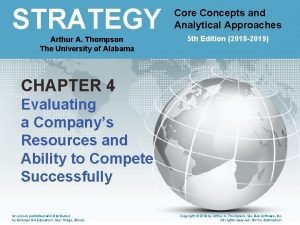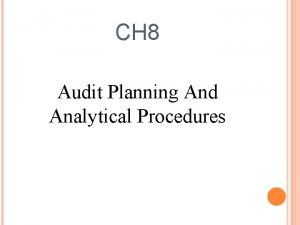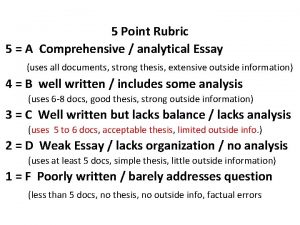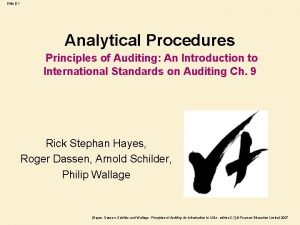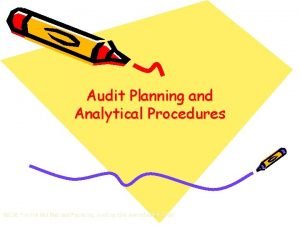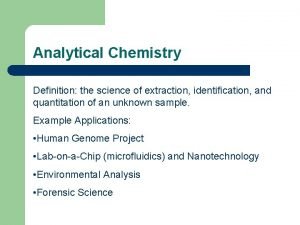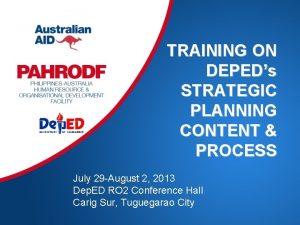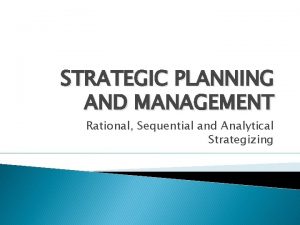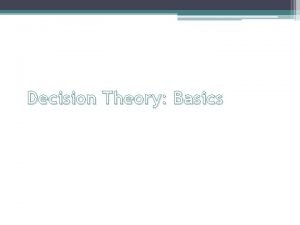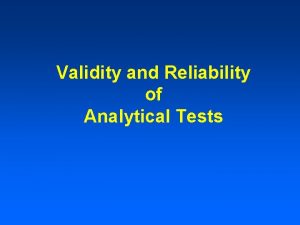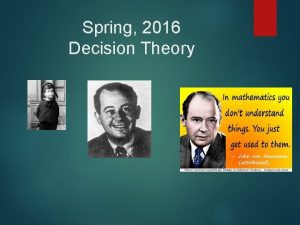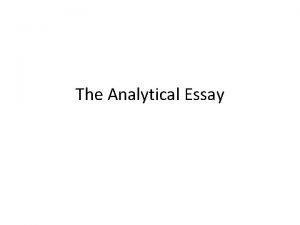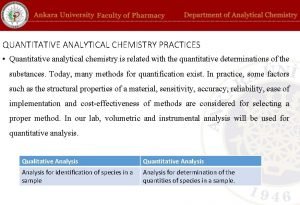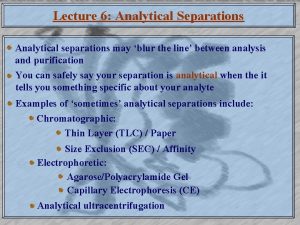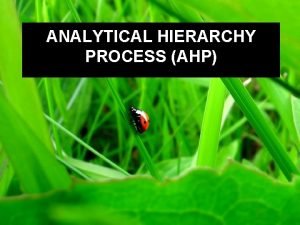DECISION THEORY Decision theory is an analytical and

















- Slides: 17

DECISION THEORY §Decision theory is an analytical and systematic way to tackle problems §A good decision is based on logic.

The Six Steps in Decision Theory 1. 2. 3. 4. Clearly define the problem at hand. List the possible alternatives. Identify the possible outcomes. List the payoff or profit of each combination of alternatives and outcomes. 5. Select one of the mathematical decision theory models. 6. Apply the model and make your decision.

Types of Decision-Making Environments § Type 1: Decision making under certainty. Ø Decision maker knows with certainty the consequences of every alternative or decision choice. Ø There is only 1 possible future outcome affecting the different alternatives. § Type 2: Decision making under risk. Ø There are 2 or more future events affecting the different alternatives and the decision maker knows the probabilities of the various future events § Type 3: Decision making under uncertainty. Ø There are 2 or more future events affecting the different alternatives but the decision maker does not know the probabilities of the various outcomes.

DECISION MAKING UNDER CERTAINTY (Financial Criteria) 1. ) Net Present Value (NPV) • NPV = Present Value of Benefits – Present value of Expenses = PVB – PVE • NPV > 0 2. ) Benefit Cost Ratio (BCR) • BCR> 1 • BCR = PVB / PVE 3. ) Payback Period (PBP) 4. ) IRR (Internal Rate of Return) 5. ) ROI (Return on Investment)

Decision Making under Uncertainty § Maximax (Optimistic) § Maximin (Pessimistic) § Simple Average/Equally likely (Laplace) § Criterion of realism (Hurwicz) § Minimax Regret

Example – DM Under Uncertainty The New Era Toy Co. , Inc. , manufactures children’s wooden toys. The company believes that the current trend toward sturdier and simpler toys will continue; thus New Era must decide among three alternative methods of providing for anticipated higher demand for its products. These are completely overhauling the existing plant and adding more machines, or buying a competitor’s plant which is available. A fourth alternative would be to limit production to the current plant capacity (do nothing). New Era Management has no information on how demand will be likely to shape up New Era’s payoff table is as follows: ALTERNATIVES DEMAND High OVERHAUL EXPAND BUY DO NOTHING $30, 000 $60, 000 $50, 000 $3, 000 Moderate 10, 000 20, 000 15, 000 2, 000 Low -5, 000 -10, 000 -20, 000 -1, 000 Failure -50, 000 -70, 000 -60, 000 -5, 000

STEPS 1. - Maximax Criterion (optimistic) Determine the payoff for each alternative Decision: Select the alternative with the highest value among the max payoffs 2. - Maximin Criterion (pessimistic) Determine the minimum payoff for each alternative Decision: Select the alternative with the highest vlaue among the minimum payoffs 3. - Simple Average Criterion (or Equally likely or Laplace) Compute the average payoff for each alternative Decision: Select the alternative with the highest average payoff 4. - Criterion of Realism (Hurwicz) Assign a weight (α ) to optimism; (1 - α ) to pessimism Compute the measure of realism for each alternative MR = α (max payoff) + (1 - α)(min. payoff) Decision: Select the alternative with the highest MR 5. - Minimax Regret Criterion (Opportunity Loss) Construct the regret table Determine the maximum regret values for each alternative Decision: Select the alternative with the lowest value among the max regret values

Decision Making under Risk 1. EXPECTED VALUE CRITERION 2. 1. 1) By Expected Monetary Value (EMV) Analysis In other words: EMV(Alternative n) = Payoff 1 * P(S 1) + Payoff 2 * P(S 2) + … + Payoff n * P(Sn) 1. 2) By Marginal Analysis -Compute the marginal probability, or the probability that would justify the increase in demand, or the effect per unit of increase Marg P = ML/ (MP+ ML) Where: MP = marginal profit or contribution margin = Unit selling price (S) – Unit Variable Cost (V) ML = marginal loss = V (if no salvage value)

Decision Making under Risk 2. MAXIMUM LIKELIHOOD CRITERION - Worth using if the highest single probability of occurrence is high enough than the other probabilities combined - Selecting the alternative with the largest payoff under the future event that is most likely to happen (i. e. , with the largest probability) 3. CRITERION OF RATIONALITY (CRITERION OF INSUFFICIENT REASON OR EQUALLY LIKELY CRITERION) - Assumes that there is an equal probability for each future event P (each event) = 1/ no. of future events

PROBLEM ON DECISION MAKING UNDER RISK A veterinarian purchases rabies immunization vaccine on Monday of each week. Because of the characteristics of this vaccine, it must be used by Friday or disposed of. The vaccine costs $9 per dose, and the vet charges $16 per dose. In the past, the vet has administered rabies vaccine in the following quantities below. Determine how many doses of rabies vaccine the veterinarian should order per week. Quantities used per week No. of weeks this occurred Probability of occurrence Cumulative probability 25 15 . 3 1. 00 40 20 . 4 . 7 50 10 . 2 . 3 75 5 . 1

STEPS 1. Expected value criterion 1. 1) By Expected Value analysis Compute the expected value for each alternative DN – Select the alternative with the highest EV 1. 2 ) By Marginal Analysis Compute the marginal probability Construct the cumulative probability (>=) “more than or equal to” DN – Select the alternative with the cum probability equal to or immediately greater than the marginal probability 2. - Max Likelihood Criterion Identify the future event that is most likely to happen (w/ the largest probability) DN – Select the alternative with the largest payoff under this event 3. - Criterion of Rationality Assume equal probability for each future event Compute for EP for each alternative DN – Select the alternative with the highest EP

TO GET PROBABILITY OF OCCURRENCE (IF NOT GIVEN) The Nelia Fruit Store stocks mangoes during the early summer season. These are flown in from Cebu each Monday and must be sold within the following week. In the past, the store has experienced the following demand for mangoes: Quantities buyers sought, unit No. of weeks this occurred 20 10 25 30 40 50 60 10

Expected Value of Perfect Information (EVPI) § EVPI places an upper bound on what one would pay for additional information. § EVPI is the expected value with perfect information (EV|PI) minus the maximum EMV. EVPI = EV|PI - maximum EMV Expected value with perfect information Expected value with no additional information

Expected Value with Perfect Information (EV|PI) In other words EV ׀ PI = Best Payoff of S 1 * P(S 1) + Best Payoff of S 2 * P(S 2) +… + Best Payoff of Sn * P(Sn)

DECISION TREES • Decision trees are most beneficial when a sequence of decisions must be made. • All information included in a payoff table is also included in a decision tree. • Structure of Decision. Tree => graphical representation where: § A decision node is indicated by a square ( ) Note: Lines drawn from the square node represent the different alternatives § A state-of-nature node is indicated by a circle ( ) Note: Lines drawn from a circular node represent the different states of nature or future events

Five Steps to Decision Tree Analysis

Example – Decision Tree Problem The management of Exact, Inc. is considering expanding its present production on the basis of increasing demand of its products. Its present production capacity is estimated to generate a net return of P 1. 6 million with high demand, or break even with low demand. If the company expands its present production to twice its present output, it has the option of buying additional machineries which will cost them P 1. 0 million, or subcontracting the additional units. If the demand is high, the first option is estimated to generate a total return of P 4. 5 million including all costs except for the purchase of the additional machineries; if the demand is low a total net loss of P 1. 4 million including the cost of the additional machineries. For the second option, the estimated total net return is P 2. 8 million if the demand is high, and total net loss of P 0. 5 million for low demand. The R&D department projected the probability of high demand to be 0. 68 and 0. 32 for low demand. Construct a decision tree diagram to help management decide whether to expand or not. If so, what is the best option to take to maximize expected net return?
 No decision snap decision responsible decision
No decision snap decision responsible decision Financial decision
Financial decision Decision tree and decision table
Decision tree and decision table Strategy core concepts and analytical approaches
Strategy core concepts and analytical approaches Analytical learning vs inductive learning
Analytical learning vs inductive learning Audit planning and analytical procedures
Audit planning and analytical procedures 5 point thesis
5 point thesis Advantages and disadvantages of analytical procedures
Advantages and disadvantages of analytical procedures Inductive vs analytical learning
Inductive vs analytical learning Difference between descriptive and analytic epidemiology
Difference between descriptive and analytic epidemiology Descriptive vs analytical epidemiology
Descriptive vs analytical epidemiology Descriptive vs analytic epidemiology examples
Descriptive vs analytic epidemiology examples Audit planning and analytical procedures
Audit planning and analytical procedures Definition of analytical chemistry
Definition of analytical chemistry Analytical intuitive functional and personal
Analytical intuitive functional and personal Deped strategic planning
Deped strategic planning Rational strategizing
Rational strategizing Difference between formal and informal reports
Difference between formal and informal reports



